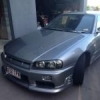Troubleshooting Gauges
Announcements
-
Similar Content
-
Latest Posts
-
By hardsteppa · Posted
Ahah..i give a friendly community reminder of the forthcoming event and that's the thanks i get 😋 Someone's gone mad with power lol. -
By Dose Pipe Sutututu · Posted
someone being a naughty boy? -
Nothing wears "the most". Different cars will always show signs in a different place. 114000 km is either nothing at all (as in, given the calendar age, nearly brand new) or it's completely unbelievable. We stopped believing numbers like that about 15 years ago. Having said that, my car is up around 270000 km and I have put bushes into some places** as many as 10 times in >25 years that I've owned it. ** FUCAs, which are different on an R32 than on a 33, so not likely to be the same issue for you. I have original ball joints all the way around. They are perfectly fine. Same with the spindle bearings in the front. Tie rod ends have all been done at least once though. Pretty much every other bush in the car has been done at least twice. Some of those in the first 100000km after I got it (which was at a genuine 23000!). Some of those bushes are now sphericals, and they are on a <cough> regular maintenance schedule, hence why my FUCAs have been rebuilt so many times. Half of those 10 in the count above would be in the last few years! 'twere I you, I would budget on replacing everything, for fun and prevention. If they really are 30 year old rubber, they will all be unpleasantly aged in one way or another. Whether that's corrosion of shells, or the rubber cracking, or sagging under the load, etc etc.
-






Recommended Posts
Create an account or sign in to comment
You need to be a member in order to leave a comment
Create an account
Sign up for a new account in our community. It's easy!
Register a new accountSign in
Already have an account? Sign in here.
Sign In Now